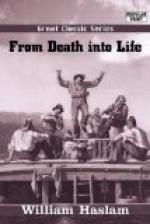He knew many legends of holy men of old, and said that the patron saints of West Cornwall were in the calendar of the Eastern Church, and those in the north of Cornwall belonged to the Western. His own patron saint, Morwenna, was a Saxon, and his church a Saxon fane. He talked of these saints as if he knew all about them, and wrote of them in a volume of poems thus:—
“They had their lodges in the wilderness,
And built them cells along the shadowy sea;
And there they dwelt with angels like a dream,
And filled the field of the evangelists
With thoughts as sweet as flowers.”
He used to give most thrilling and grand descriptions of the storms of the Atlantic, which broke upon the rocky coast with gigantic force, and tell thrilling stories of shipwrecks; how he saved the lives of some of the sailors, and how he recovered the bodies of others he could not save. Then in the churchyard he would show you—there, a broken boat turned over the resting-place of some; here, two oars set up crosswise over several others; and in another part the figure-head of a ship, to mark the spot where the body of a captain was buried.
The Vicarage house was as original as himself. Over the door was inscribed—
“A house, a glebe, a pound a day;
A pleasant place to watch and pray.
Be true to Church, be kind to poor,
O minister, for evermore!”
The interior was furnished with old-fashioned heavy furniture and the outside was conspicuous for its remarkable chimneys, which were finished off as models of the towers of churches where he had served. The kitchen chimney, which was oblong, perplexed him very much, till (as he said) “I bethought me of my mother’s tomb; and there it is, in its exact shape and dimensions!”
He had daily service in his church, generally by himself, when he prayed for the people. “I did not want them there.” he said. “God hears me; and they know when I am praying for them, for I ring the bell.”
He had much influence in his parish, chiefly amongst the poor, and declared that his people did whatever he told them. They used to bring a bunch of flowers or evergreens every Sunday morning, and set them up in their pew ends, where a proper place was made to hold them. The whole church was seated with carved oak benches, which he had bought from time to time from other churches, when they were re-pewed with “deal boxes!”
On the Sunday, I was asked to help him in the service, and for this purpose was arrayed in an alb, plain, which was just like a cassock in white linen. As I walked about in this garb, I asked a friend, “How do you like it?” In an instant I was pounced upon, and grasped sternly on the arm by the Vicar. “‘Like’ has nothing to do with it; is it right?” He himself wore over his alb a chasuble, which was amber on one side and green on the other, and was turned to suit the Church seasons; also a pair of crimson-colored gloves, which, he contended, were the proper sacrificial colour for a priest.




